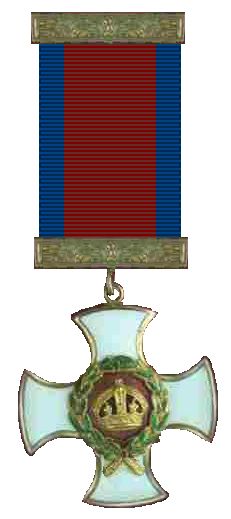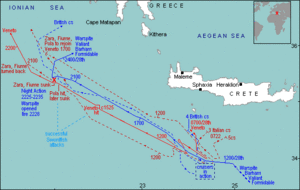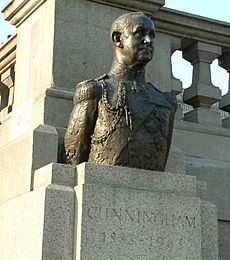Andrew Cunningham, 1st Viscount Cunningham of Hyndhope facts for kids
Quick facts for kids
The Viscount Cunningham of Hyndhope
|
|
|---|---|
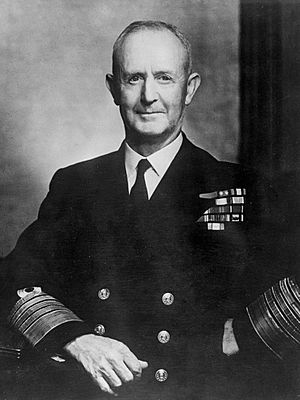
Cunningham in 1943
|
|
| Birth name | Andrew Browne Cunningham |
| Nickname(s) | "ABC" |
| Born | 7 January 1883 Rathmines, Ireland |
| Died | 12 June 1963 (aged 80) London, England, United Kingdom |
| Place of burial |
Buried at sea off Portsmouth
|
| Allegiance | United Kingdom |
| Service/ |
Royal Navy |
| Years of service | 1897–1946 |
| Rank | Admiral of the Fleet |
| Commands held | HMS Scorpion HMS Rodney Battlecruiser Squadron Mediterranean Fleet First Sea Lord |
| Battles/wars | |
| Awards | Viscountcy of Hyndhope Knight of the Order of the Thistle Knight Grand Cross of the Order of the Bath Member of the Order of Merit Distinguished Service Order & Two Bars |
| Relations | General Sir Alan Cunningham (brother) |
| Other work | Lord High Commissioner to General Assembly of Church of Scotland Lord High Steward |
Andrew Browne Cunningham (born January 7, 1883 – died June 12, 1963) was a famous British naval officer during the Second World War. He was born in Ireland and was widely known by his initials, "ABC".
Cunningham joined the Royal Navy in 1897. He commanded a destroyer during the First World War. He also served through most of the years between the two World Wars. He earned the Distinguished Service Order medal three times for his brave actions.
During the Second World War, Cunningham became the Commander-in-Chief of the Mediterranean Fleet. He led British naval forces to important victories in the Mediterranean Sea. These included the attack on Taranto in 1940 and the Battle of Cape Matapan in 1941. He was in charge of protecting important supply routes for Britain. In 1943, he became the First Sea Lord, which is the top professional leader of the Royal Navy. He held this position until he retired in 1946. After the war, he received special honors and took part in important ceremonies. He passed away in 1963 at the age of 80.
Contents
Cunningham was born in Rathmines, County Dublin, Ireland, on January 7, 1883. He was the third of five children. His father was a professor of anatomy, and his mother managed the home. He had a very close relationship with his mother. His younger brother, Sir Alan Cunningham, also became a famous general.
After starting school in Dublin and Edinburgh, he received a telegram from his father at age ten. It asked if he wanted to join the Navy. Even though his family had no naval background, he replied, "Yes, I should like to be an Admiral." He then went to a special school, Stubbington House School, to prepare for the Navy entrance exams. He passed with excellent marks, especially in math.
On January 15, 1897, Cunningham joined the Royal Navy as a cadet. He trained on the ship HMS Prince of Wales (1860) (Britannia) in Dartmouth. One of his classmates was Sir James Somerville, who also became a top admiral. Cunningham was known for enjoying boats and being adventurous. He finished his training in April 1898 with very good conduct marks.
Cunningham's first assignment was on HMS Doris in 1899. He served in South Africa during the Second Boer War. He even joined the Naval Brigade on land, hoping for chances to show bravery. He fought in battles like Pretoria and Diamond Hill.
He continued to serve on various ships and was promoted to lieutenant in 1904. In 1908, he received his first command: HM Torpedo Boat No. 14. This was a small, fast ship designed to fire torpedoes.
World War I Service
During the First World War, Cunningham was a highly respected officer. He received the Distinguished Service Order (DSO) three times for his excellent service. From 1911, he commanded the destroyer HMS Scorpion throughout the war.
In 1914, Scorpion was involved in chasing two German warships, Goeben and Breslau. These ships managed to escape through the Dardanelles to reach Constantinople. Their arrival helped the Ottoman Empire join the war against Britain. This event had a huge impact on the war.
Cunningham stayed in the Mediterranean. In 1915, Scorpion took part in the attack on the Dardanelles. For his actions, Cunningham was promoted to commander in July 1915 and received his first DSO. He spent much of 1916 protecting convoys, which were groups of ships traveling together for safety. He was known for his excellent seamanship. In 1918, he moved to HMS Termagant and earned a second DSO for his work with the Dover Patrol.
Between the World Wars
After World War I, Cunningham continued to serve actively. In 1919, he commanded Seafire in the Baltic. Here, he worked with Admiral Walter Cowan. Cunningham was very impressed by Cowan's leadership, especially in dangerous, foggy, and mine-filled waters.
Cunningham showed great control and good judgment during encounters with German forces. Cowan praised him for his quick and brave decisions. For his actions in the Baltic, Cunningham received a third DSO.
He was promoted to captain in December 1919. He commanded several destroyer flotillas and naval bases. From 1926 to 1928, he worked again with Admiral Cowan in Bermuda. Cunningham learned many valuable lessons from Cowan.
In 1929, Cunningham married Nona Byatt. They did not have any children. Later, he commanded his first large ship, the battleship Rodney.
Becoming an Admiral
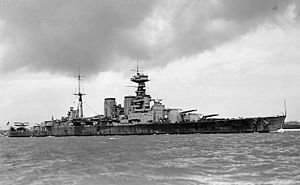
In September 1932, Cunningham was promoted to flag rank, becoming a Rear Admiral. He was put in charge of destroyers in the Mediterranean in 1933. He used this time to practice how to handle a large fleet. He also learned about night actions, which would be very useful later in World War II.
In July 1936, he became a vice admiral. A year later, he became the second-in-command of the Mediterranean Fleet, with HMS Hood as his main ship. He loved the spacious living quarters on Hood after years on smaller ships.
In 1938, he moved to the Admiralty in London as Deputy Chief of the Naval Staff. He didn't enjoy office work, but his high standing was clear. In 1939, he was knighted, becoming Sir Andrew Cunningham.
World War II: Commander in the Mediterranean
Cunningham believed that commanding the Mediterranean Fleet was the best job in the Royal Navy. He knew the Mediterranean Sea very well. He became Commander-in-Chief, Mediterranean, on June 6, 1939. His main goal was to protect convoys (groups of supply ships) going to Egypt and Malta. Malta was a very important British naval base. Cunningham knew that the main threat would come from the Italian Fleet. He kept his fleet ready for action.
Dealing with the French Fleet (1940)
In June 1940, after France surrendered to Germany, Cunningham had a difficult task. He had to make sure that French warships in Alexandria did not fall into enemy hands. He had to negotiate with the French Admiral René-Émile Godfroy.
The British government ordered Cunningham to make sure the French ships were disarmed. It was a tense time, especially after the British attacked other French ships at Mers el Kebir. But Cunningham managed to make a personal agreement with Godfroy. The French ships emptied their fuel and removed their gun parts. Cunningham promised to send the French sailors home. This avoided a battle between former allies.
The Attack on Taranto (1940)
Even with the French fleet dealt with, the Italian fleet was still a threat. The Italians kept their ships in harbor, which meant they could suddenly attack at any time. The main Italian base at Taranto had six battleships and many other warships. The British planned a surprise attack called Operation Judgement. They sent the new aircraft carrier HMS Illustrious to join Cunningham's fleet.
The attack began on November 11, 1940, at 9:00 PM. Fairey Swordfish torpedo bombers took off from Illustrious in two waves. The attack was a huge success. The Italian fleet lost half its strength in one night. This greatly reduced the threat to British control of the Mediterranean. Cunningham said that this attack showed how powerful naval aircraft could be. The Japanese studied this attack when planning their own attack on Pearl Harbor in 1941.
After seeing photos of the damage, Cunningham sent a short but famous message: "Manoeuvre well executed."
The Battle of Cape Matapan (1941)
In March 1941, Germany wanted to stop British supply convoys going to Greece. The Italian Navy planned to attack the British fleet on March 28, 1941. The Italian commander, Admiral Angelo Iachino, wanted to surprise the British.
However, Cunningham knew about Italian naval movements because the British were decoding their secret messages. Cunningham pretended to be busy with golf and a party to trick enemy spies. Then, he secretly boarded his flagship, HMS Warspite, and left Alexandria.
Cunningham ordered an air attack from Formidable's torpedo-bombers. One hit the Italian battleship Vittorio Veneto, slowing it down. The Italian admiral, realizing his fleet was in danger without air cover, ordered them to retreat. Cunningham ordered his fleet to chase them.
Another air attack disabled the Italian cruiser Pola. The Italian admiral, not knowing Cunningham's main battle fleet was close, sent ships back to protect the Pola. The British fleet, using radar, found the Italian ships after 10:00 PM. In a key moment, the British battleships Barham, Valiant, and Warspite opened fire on two Italian cruisers from very close range. They destroyed them in just five minutes.
The Vittorio Veneto escaped, but the Battle of Cape Matapan was a major British victory. Five Italian ships were sunk, and about 2,400 Italian sailors were lost. The British lost only three aircrew. This defeat, along with Taranto, meant the Italian Navy stayed in port for the rest of the war.
The Battle of Crete (1941)
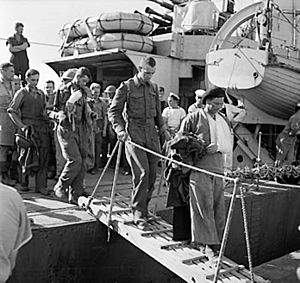
On May 20, 1941, Nazi Germany launched an airborne invasion of Crete. German paratroopers landed and, despite heavy losses, captured an airfield. This allowed them to bring in more troops and overwhelm the Allied forces.
After a week of intense fighting, British commanders decided they had to withdraw. Over four nights, 16,000 troops were evacuated by ship to Egypt. However, without air cover, Cunningham's ships suffered heavy losses from German dive bombers.
Cunningham was determined not to let the army down. When generals worried about losing too many ships, Cunningham famously said:
It takes the Navy three years to build a ship. It will take three hundred years to build a new tradition. The evacuation will continue.
Thanks to Cunningham's strong will, 16,500 men were rescued. But the Navy lost three cruisers and six destroyers, and 15 other warships were damaged.
North Africa and Sicily (1942–43)
In 1942, Cunningham was honored as a Knight Grand Cross of the Order of the Bath. From late 1942 to early 1943, he worked under General Dwight D. Eisenhower, who was the overall Allied commander. Cunningham became the Naval Commander for the Allied Expeditionary Force. In this role, he led the huge fleet that supported the Anglo-American landings in North Africa, known as Operation Torch. General Eisenhower greatly admired Cunningham's leadership and dedication.
On January 21, 1943, Cunningham was promoted to Admiral of the Fleet, the highest rank in the Royal Navy. In February 1943, he returned to lead the Mediterranean Fleet. When Axis forces in North Africa were about to surrender, he gave a famous order: "Sink, burn and destroy: Let nothing pass." This meant no enemy ships should escape.
He also oversaw the naval forces for the Allied invasions of Sicily (Operation Husky) and Italy (Operation Avalanche). On September 11, 1943, Cunningham was in Malta when the Italian Fleet officially surrendered. He sent a memorable telegram to London: "Be pleased to inform their Lordships that the Italian battle fleet now lies at anchor under the guns of the fortress of Malta."
First Sea Lord (1943-46)
In October 1943, Cunningham became the First Sea Lord and Chief of the Naval Staff. This meant he was the professional head of the Royal Navy. He had to leave his beloved Mediterranean command. As First Sea Lord, Cunningham was in charge of the Navy's overall strategy for the rest of the war. He attended major conferences with Allied leaders like Winston Churchill and Franklin D. Roosevelt, discussing plans for the invasion of Normandy and sending a British fleet to the Pacific.
Retirement and Legacy

In January 1945, Cunningham received another high honor, becoming Baron Cunningham of Hyndhope. He could have retired at the end of the war, but he stayed on to help the Navy transition back to peacetime. This was a challenging time due to budget cuts.
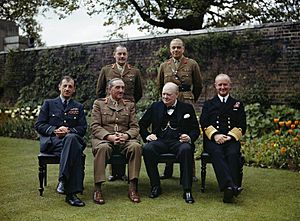
In October 1945, he was elected Rector of the University of Edinburgh. In 1946, he was made Viscount Cunningham of Hyndhope and received the Order of Merit. At the end of May 1946, he retired from his post as First Sea Lord.
Cunningham and his wife, Nona, retired to their home in Hampshire. He took on several ceremonial roles. He was Lord High Commissioner to the General Assembly of the Church of Scotland in 1950 and 1952. In 1953, he was the Lord High Steward at the coronation of Queen Elizabeth II.
Andrew Cunningham passed away in London on June 12, 1963, at age 80. He was buried at sea off Portsmouth. Since he had no children, his titles ended with him.
A statue of Cunningham was unveiled in Trafalgar Square in London in 1967. In 2010, a British naval operation to help people stranded in Europe by a volcanic ash cloud was named Operation Cunningham in his honor.
Arms
|
See also
 In Spanish: Andrew Browne Cunningham para niños
In Spanish: Andrew Browne Cunningham para niños


